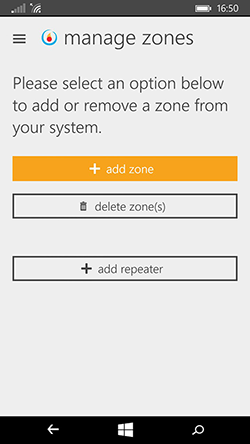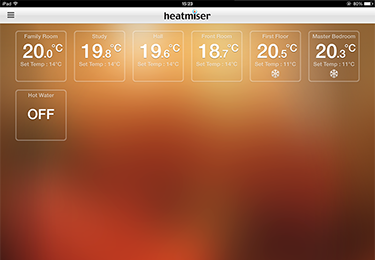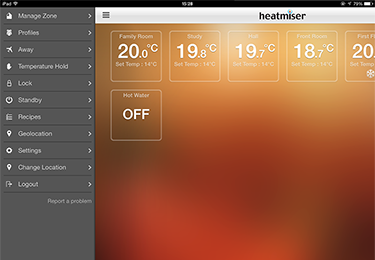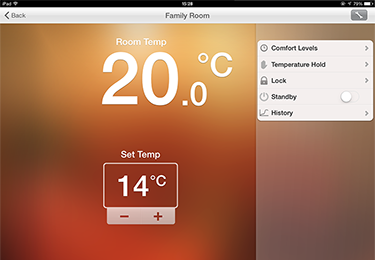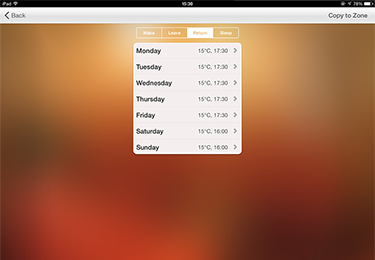Getting Up and Running
The thermostats look great in situ and the initial setup process is relatively straight forward. You start by taking the compact 150mm x 91mm x 27mm neoHub and attaching it to your broadband router and a mains power supply using the bundled adaptor and cable. The hub claims an IP address and configures itself automatically, with no pesky port-forwarding involved.
The next step requires the Heatmiser Neo app, so you'll need an iOS, Android or Windows Phone device. Once you've loaded the app and created a free account, you need to wirelessly pair each neoStat to the neoHub by adding zones one after another. The process entails a sequence of key presses on the neoStat in order to enter a pairing mode, and once the app has discovered the thermostat it can be named and saved before you move on to the next room/zone.
All six zones and the hot-water programmer were discovered and added without a hitch, and the neoStats create their own wireless mesh network, so while one thermostat will need to be within range of the neoHub, any additional neoStats can daisy-chain to each other. I had reservations over whether or not the thermostat on the top floor would maintain a reliable connection, but the mesh network has remained rock solid over the past couple of months.
Configuring the zones is quick and easy, however the process does highlight a shortcoming: the controls on each neoStat aren't the most intuitive. Each stat has five touch-sensitive buttons below the screen - left, tick, right, up and down - and though the buttons are responsive, they lead to a tiered menu system that's full of numbers and difficult to decipher without the manual. It's all a bit technical.
The 'dumb' heating programmers we've used in the past have been able to provide an hour's top-up of heat at the press of a boost button, but there's no such function on the 'smart' neoStat. You can set a Temperature Hold, which overrides the current program and sets a defined temperature for a desired period, but doing so requires half-a-dozen or so button presses, and if you want to get an extra hour of heat in multiple zones the on-device controls become a bit of a chore.
It's All About The Apps
Like so many of today's gadgets, Heatmiser Neo relies heavily on an app ecosystem that acts as the primary method of interacting with the system. The good news, as we've mentioned already, is that the Heatmiser Neo app is available on multiple platforms, including iOS, Android and Windows Phone. The bad news is that the apps are quite basic and don't do enough to impress on either platform.
In contrast to many of its competitors, Heatmiser's Neo isn't a learning thermostat and will not do anything fancy such as react to the weather forecast or automate heating schedules based on your usage. Instead, it's primary selling point is the ability to "control your heating and hot water from anywhere."
This is achieved through a simple-looking interface that offers many of the right controls but does so in a manner that's sluggish to navigate and, like the neoStat's on-screen controls, not the most intuitive to use. Take, for example the profile selection screen, where there's a drop-down menu that doesn't actually drop down - instead the options are confusingly displayed in a scrolling list at the bottom of the screen. Such oddities are scattered throughout the app, and these are inconsistencies that should be picked up on during a beta test.
The bulk of in-app navigation is achieved via a side-loaded menu that allows switching between different areas of the admin panel. Moving from one area to the next should be instant, however we would assume that settings are pulled on demand from the neoHub or a remote server, as switching from one page to another can take up to 10 seconds, leading us to believe that data is not cached locally.
Offering somewhat simple functionality, each neoStat can also only be configured to turn on and off twice each day. The idea, we guess, is that the heating is typically programmed before or after work, but it seems an unnecessary restriction on a premium thermostat. The 'dumb' programmer I've replaced offered three on/off periods per day, so the Heatmiser Neo is a step backward in this regard.
On the plus side, once you've configured a single stat the programmed schedule can be copied to other zones, taking away the extra legwork typically involved in setting up a multi-zone system. Similarly, the time is auto configured, meaning you won't need to go round adjusting all the neoStats each time daylight saving kicks in.
It's possible to create multiple profiles, giving other family members control of the system, and there's also the option for a guest account that can be configured to terminate after a user-defined period. Handy if you can afford to kit out your holiday home with smart thermostats.
An away function lets you turn off the heating and water for a chosen number of days, and you can also lock individual neoStats to prevent kids or guests tampering with your intricate settings. Do be careful when using the away mode, as the thermostats actually display how many days are left until you return home - that's of little use to you when you're not there, but it could be great for burglers who now know when you're due back.
Two of Heatmiser's more recent feature additions - Recipes and Geolocation - are showing more promise. The former lets you create a sequence of actions that can be run run from an in-app shortcut - for example Temperature Hold, Zones 1-4, 23ºC for one hour - while the latter uses GPS to turn off the heating when you're a certain distance from home. Said functionality hasn't yet come to the Windows Phone app so I'm unable to judge how well it works, but going by reviews of the iOS and Android apps, the consensus seems to be Geolocation is patchy at best.
Outside of these core functions, it's a surprise to find that the Neo apps don't offer any energy-saving tips or statistics. There are advanced features such as Output Delay and Optimum Start, however there's little insight in how best to configure the neoStats for efficient operation. We'd like to see the app point out when the heating is being used efficiently, and ultimately whether or not money is being saved, but there are no such suggestions and we reckon Heatmiser has missed a trick in not playing on the smart thermostat's energy-saving potential.
The technology available to the neoStat presents so many opportunities that it feels as though the current software is one step behind. When the weather outside is cold, why can't the stats automatically switch to a certain profile? Why can't the on-device buttons be re-programmed to a shortcut of my choosing? And given the amount of data that must be available, why can't the apps tell me if I've used more or less heating compared to the same time period last year?
That's the sort of direction Heatmiser needs to take if its to keep pace with rival manufacturers, however as it stands the Neo apps aren't doing enough to maximise the system's capabilities. The company tells us that a system update is due soon and should bring with it performance enhancements, but there's no firm date on much-needed app updates. Case in point, the stagnant Android and Windows Phone apps haven't been updated since November 2014.






